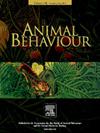The courtship song of voles: male ultrasound vocalizations modulate female receptivity in two vole species
IF 2.3
2区 生物学
Q2 BEHAVIORAL SCIENCES
引用次数: 0
Abstract
Rodents use ultrasonic vocalization (USVs) during various social interactions. The research on the impact of USVs is predominantly focused on common laboratory species; however, their exact role in rodents' lives remains unknown. Within vole species, USVs are present during sexual encounters and are primarily emitted by males. Female voles, characterized as induced ovulators, require male stimuli for behavioural oestrus and ovulation. Ultrasounds occurring during male–female interactions may thus serve as external stimuli influencing female reproductive behaviour. In this study, using prerecorded male vocalization, we investigated the effects of male USVs on female proceptive and receptive behaviours towards males in two lab-bred wild-derived vole species: bank voles, Clethrionomys glareolus or Myodes glareolus and common voles, Microtus arvalis. The confrontation between males and females was performed after a significant delay following exposure to the vocalization, rather than immediately afterwards. This approach allowed us to investigate the delayed reactions of females. Our findings reveal that exposure to male USVs before behavioural tests significantly influenced the reproductive behaviour of females in both species. Specifically, we observed an increased frequency of lordosis positions and copulations after the ultrasound exposure, however with variations in the response timing between species. Furthermore, ultrasound exposure notably reduced the latency to the first copulation, suggesting changes in female physiology induced by the USVs. Taken together, this work underscores the significance of male USV as a potential stimulus capable of influencing female voles’ behaviour and potentially their physiology, resulting in enhanced receptivity.
田鼠的求偶之歌:雄性超声发声调节两种田鼠的雌性接受性
啮齿动物在各种社会互动中使用超声波发声(USVs)。关于usv影响的研究主要集中在常见的实验室物种上;然而,它们在啮齿动物生活中的确切作用仍然未知。在田鼠物种中,usv存在于性接触中,主要由雄性释放。雌性田鼠的特点是诱导排卵,需要雄性刺激来进行行为发情和排卵。因此,在男女相互作用时产生的超声波可能作为影响女性生殖行为的外部刺激。在这项研究中,我们利用预先录制的雄性发声,研究了雄性usv对两种实验室培育的野生田鼠物种——银田鼠(Clethrionomys glareolus或Myodes glareolus)和普通田鼠(Microtus arvalis)——雌性对雄性的感知和接受行为的影响。雄性和雌性之间的对抗是在听到声音后的明显延迟后进行的,而不是立即进行的。这种方法使我们能够研究雌性的延迟反应。我们的研究结果表明,在行为测试之前暴露于雄性usv显著影响了两个物种的雌性生殖行为。具体来说,我们观察到超声波暴露后前凸位置和交配频率增加,但不同物种之间的反应时间有所不同。此外,超声波暴露显著减少了第一次交配的潜伏期,这表明usv引起了雌性生理的变化。综上所述,这项工作强调了雄性USV作为一种潜在刺激的重要性,它能够影响雌性田鼠的行为和生理,从而增强其接受性。
本文章由计算机程序翻译,如有差异,请以英文原文为准。
求助全文
约1分钟内获得全文
求助全文
来源期刊

Animal Behaviour
生物-动物学
CiteScore
4.60
自引率
8.00%
发文量
236
审稿时长
10.2 weeks
期刊介绍:
Growing interest in behavioural biology and the international reputation of Animal Behaviour prompted an expansion to monthly publication in 1989. Animal Behaviour continues to be the journal of choice for biologists, ethologists, psychologists, physiologists, and veterinarians with an interest in the subject.
 求助内容:
求助内容: 应助结果提醒方式:
应助结果提醒方式:


